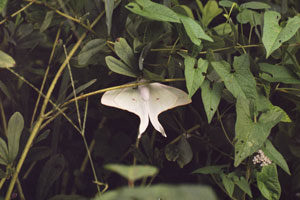Vol. 12 Issue 2, Summer 2007
By Ginger Walker
Many people say that they will never forget their first sight of a Luna Moth, and that has certainly been my experience. When my family moved from Alaska to Virginia when I was ten years old, many elements of the southeast’s ecology startled me. One summer morning, my mother found an extraordinary green moth on our front porch. Assuming it was dead, she placed it in a jar on her bedroom dresser. A thunderstorm roared through our neighborhood that night, and in a flash of lightning the moth came alive in the jar and fluttered around so violently that it woke my mother up.

Photo by Nicole Hamilton
Luna Moths (Actias luna) were once common in our area, but now it is a rare treat to see these lovely creatures in most parts of Loudoun County. Luna Moths are members of the silkworm family, which includes other giant local moths such as the Polyphemous Moth. Luna Moths are easy to identify by their pale green color and long “tail streamers.”
The caterpillars are the archtypical cartoon caterpillar with soft, squishy green bodies. They are able to eat a variety of tree leaves, including walnut leaves which are poisonous to many other species of caterpillar. Luna Moth cocoons look like dead, dry leaves. After the moth emerges from the cocoon, it will live for just one week. Luna Moths have no mouths, so they do not eat in this stage. Their only goal is mating and egg-laying, and the moths can mate for hours at a time.
The Luna Moth only flies at night, which is how it earned its name, meaning “moon.” If you find one during the day, it will probably be “frozen,” just like the moth my mother found. If you discover one of these beautiful silkworm moths, leave it undisturbed. When night falls, the moth will fly again!

